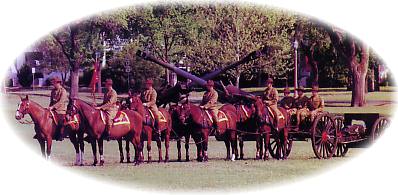Fort Sill, Oklahoma

Founded by Gen. Phillip Sheridan during a winter campaign against the Southern Plains tribes in 1869, Ft. Sill became the home of the U.S. Field Artillery Center and School in 1911. The \"Buffalo Soldiers\" of the 9th and 10th cavalry were stationed here in the late 1870\'s and provided major assistance in the construction of the post. Many of the original structures are still in use and in mint condition.
The Old Post Quadrangle features historic homes, museum buildings and the Old Post Chapel. Services have been conducted continuously in the Chapel since its founding in 1875. The museum\'s Visitor Center is located at the southeast corner of the quadrangel. Orginally designed to function as a warehouse, this building was used as Infantry barracks, a school for children and an Artillery classroom. Today, it houses an exhibits gallery and theater.
The Old Stone Corral was built in 1870 after a Kiowa horse stealing raid to protect livestock and serve as a refuge for the garrison. Present day exhibts contain horse drawn vehicles, a replica of the Post Traders\'s Store, and blacksmithing. The Old Post Gift Shop is located on the south side of the corral. Flipper\'s Ditch, built by Lt. Henry O. Flipper, the first black West Point graduate, is another historic site you will want to visit.
Many ceremonies on Fort Sill are accompanied by the Fort Sill Half Section - the Army\'s last horse-drawn field artillery unit. Half Section members dress in vintage uniforms and fire a 75mm cannon.
The Fort Sill Museum has 26 historic buildings including seven with exhibits on the Frontier Army, Native Americans and Field Artillery. One of the these, the Old Post Guardhouse erected in 1873, is famous as the holding facility for Geronimo. It now houses exhibits commemorating the horse soldiers, foot soldiers and Native Americans of the Southern Plains.
The Cannon Walk includes historic field artillery weapons from around the world. The largest piece exhibited is Atomic Annie, the 280mm gun that fired the world\'s first atomic artillery round in 1953. Other displays include Missile Park chronicling the Army\'s missile program and a display of Operation Desert Storm artillery and weapons.
While on Post, visit Geronimos\' Grave, the final resting place of the great Apache warrior. Other points of interest include the Apache and Comanche cemeteries. Native American notables such as Quanah Parker, Santanta and Satank are buried at Chief\'s Knoll in the Post Cemetery.